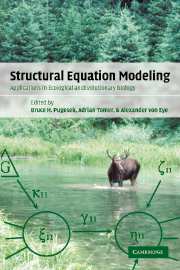Book contents
- Frontmatter
- Contents
- List of contributors
- Preface
- Section 1 Theory
- 1 Structural equation modeling: an introduction
- 2 Concepts of structural equation modeling in biological research
- 3 Modeling a complex conceptual theory of population change in the Shiras moose: history and recasting as a structural equation model
- 4 A short history of structural equation models
- 5 Guidelines for the implementation and publication of structural equation models
- Section 2 Applications
- Section 3 Computing
- Index
5 - Guidelines for the implementation and publication of structural equation models
Published online by Cambridge University Press: 14 October 2009
- Frontmatter
- Contents
- List of contributors
- Preface
- Section 1 Theory
- 1 Structural equation modeling: an introduction
- 2 Concepts of structural equation modeling in biological research
- 3 Modeling a complex conceptual theory of population change in the Shiras moose: history and recasting as a structural equation model
- 4 A short history of structural equation models
- 5 Guidelines for the implementation and publication of structural equation models
- Section 2 Applications
- Section 3 Computing
- Index
Summary
Abstract
Although distinctions are commonly made between exploratory and confirmatory models, structural equation modeling (SEM) is not an exploratory statistical method per se. The successful implementation of a structural equation model requires considerable a priori knowledge of the subject matter under investigation. The researcher will usually have a theoretical model in mind to test, and measurement instruments, including latent variables, devised to measure and relate constructs within the model. Research with SEM is a process in which theory is devised, data are collected and analyzed, and models are tested, modified, and confirmed with new data in an iterative fashion. In this context, SEM is rightly viewed as a confirmatory method. As a consequence, a number of epistemological and technical issues require consideration over and above the pure mathematics of the SEM model. In this chapter, we provide background on the philosophical aspects of the study of dependence relationships with SEM, the formulation of latent constructs, model justification, model identification, sample size and power, estimation methods, evaluation of model fit, model modification, interpretation of results, and publication of results. Our objective is to provide a guide that researchers can use to successfully devise and report the results of an SEM study.
Information
- Type
- Chapter
- Information
- Structural Equation ModelingApplications in Ecological and Evolutionary Biology, pp. 125 - 140Publisher: Cambridge University PressPrint publication year: 2003
Accessibility standard: Unknown
Why this information is here
This section outlines the accessibility features of this content - including support for screen readers, full keyboard navigation and high-contrast display options. This may not be relevant for you.Accessibility Information
- 13
- Cited by
